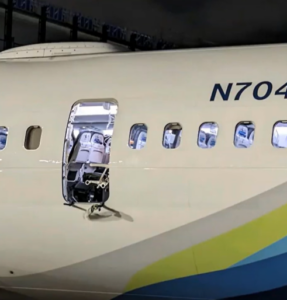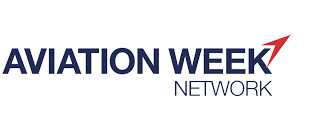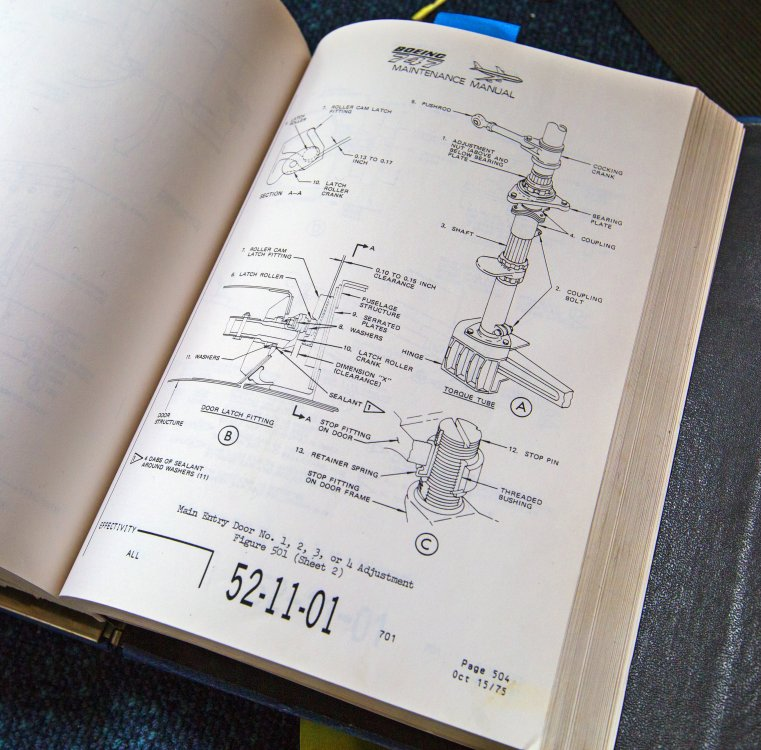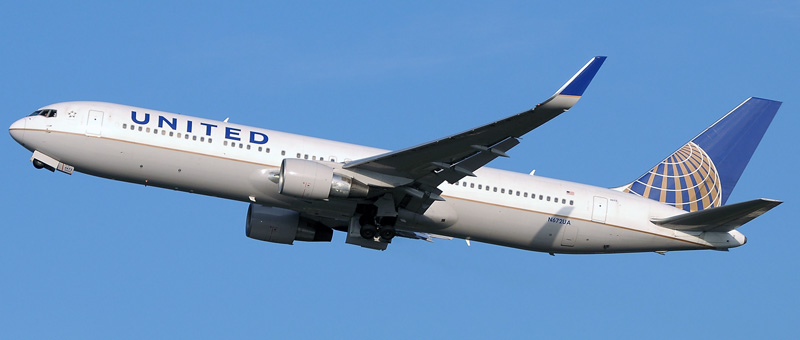Leeham News and Analysis
There's more to real news than a news release.
Boeing to Suppliers: FAA audit of 737 could change production schedule, but stick to plan for now
[Ed. note: The headline and top of this story have been reworded for clarity.]
Subscription required
By Dan Catchpole

Boeing’s Ihssane Mounir talks to suppliers at the 2024 Pacific Northwest Aerospace Alliance conference.
Feb. 8, 2024 © Leeham News: The head of the Boeing Commercial Airplanes supply chain told suppliers to keep making parts for the 737 MAX at the existing production schedule while the Federal Aviation Administration scrutinizes Boeing’s production of the single-aisle jetliner. He added that the production pace could be affected by the FAA’s audit results, which are expected in March.
“I would ask all of you to bear with us,” BCA senior vice president of Global Supply Chain and Fabrication Ihssane Mounir said at an aerospace supplier conference on Wednesday. “Let us get through this process with the FAA, the audit process, and see what the findings are and how we mitigate those findings…and what it’s going to take to get back to the production rates as we forecasted them before.”
The current schedule has the 737 production lines going to 42 airplanes per month starting this month. However, in the wake of a door plug panel blowing out of a two-month-old 737 MAX 9 flown by Alaska Airlines, the FAA on Jan. 24, told Boeing it could not increase the production rate past 38 airplanes per month. The planemaker already had been struggling to deliver that many MAXes each month.
Mounir said quality and safety trump every other concern and that Boeing and its suppliers have to get back to basics when it comes to ensuring quality. For the time being, he told suppliers, “If you have an issue, please call, and we’ll work with you.”
Summary
- Mounir: Quality trumps everything else
- Boeing urges suppliers to voice concerns
NTSB confirms door plug bolts were missing on Boeing 737-9 MAX
By the Leeham News Team
Feb. 7, 2024, © Leeham News: The National Transportation Safety Board (NTSB) yesterday issued its preliminary report on the Alaska Airlines Flight 1282 structural failure on Jan. 5 this year. (A link to the report is below.)

The emergency exit door plug separated from the two-month-old Boeing 737-9 MAX due to faulty installation, the National Transportation Safety Board confirmed.
A door plug on an emergency exit on a two-month-old Boeing 737-9 MAX blew off the airplane as it passed more than 16,000 ft shortly after takeoff from Portland (OR). Nobody was killed and only a few injuries occurred. The flight crew made an emergency landing in Portland a few minutes later.
Within days, the focus for the incident landed on Spirit AeroSystems, which makes the fuselages and installed the door plug, and on Boeing, which completed final assembly at its Renton (WA) 737 plant. Quality assurance, or “quality escape” in aviation jargon, was suggested to be issues at Spirit and Boeing.
LNA’s Bjorn Fehrm quickly concluded that four bolts meant to hold the door plug in position after installation were missing. The bolts are designed to prevent the plug from moving upward off flanges that hold the plug in place in the fuselage opening.
The NTSB’s investigation confirmed that these four bolts were missing after Boeing removed and reinstalled the plug to fix a quality escape from Spirit affecting the plug. Boeing employees failed to reinstall the plug.
Removing the plug is not a standard final assembly procedure. It’s called an “unplanned removal.” There is a specified procedure to reinstall an unplanned removal. It appears that Boeing failed to follow its own procedures.
LNA on Jan. 15 detailed the procedures for unplanned removals and reinstallation.
Related articles
- Unplanned removal, installation procedures at Boeing
- 737 incidents prompt new scrutiny at Boeing
- Alaska 1282 isn’t a “MAX” story, it’s a quality assurance issue at Boeing and Spirit
Quality Will Drive Pay for Spirit Executives
By Dan Catchpole
Feb. 6, 2024 © Leeham News: Quality more than quantity will drive Spirit Aerosystems executives’ compensation when the company unveils its new formula when it files its proxy statement in March, the company’s CEO Pat Shanahan told Wall Street analysts on Tuesday. 
“It will be significantly different, and the heaviest weighting will be only quality,” he said during a conference call discussing Spirit’s fourth quarter earnings report.
The panel blowout on Alaska Airlines Flight 1282 last month highlighted ongoing quality problems at Spirit and Boeing. Unlike the violent decompression on the 737 MAX 9, the quality problems typically just create financial headaches and public embarrassment for the two companies.
Spirit recorded $59M in net income, 48 cents adjusted earnings per share, and $42M free cash flow in the fourth quarter of 2023, its first profitable quarter since the beginning of 2022.
The company’s performance was boosted by a contract renegotiation and financing deal signed with Boeing in October. Spirit is getting close to signing a similar deal with Airbus, Shanahan said.
Summary
- Quality metrics for exec compensation
- Short term, long term plans for improving quality
- Negotiations with Airbus
Aboulafia calls for “regime change now” at Boeing
By Scott Hamilton
Feb. 6, 2024, © Leeham News: With hundreds of new 737 MAXes facing delays due to the Federal Aviation Administration’s freeze on production rates, how much compensation will Boeing owe airlines and lessors?
 It’s a question that’s unanswered at this time. And much depends on whether the delays are “excusable” or “inexcusable” in Boeing’s contracts.
It’s a question that’s unanswered at this time. And much depends on whether the delays are “excusable” or “inexcusable” in Boeing’s contracts.
Excusable delays are things outside of Boeing’s control, such as Acts of God, War, pandemics, etc. Inexcusable delays are things within Boeing’s control. However, there could be legal maneuvering as to just what this means. Is grounding by the Federal Aviation Administration—something outside Boeing’s control—an excusable or inexcusable delay if the grounding is caused by something within Boeing’s control?
Are problems within Boeing’s supply chain outside of its control but which delays deliveries by Boeing excusable or inexcusable delays? Contract language (which LNA has not seen) may address this.
Lawyers will argue over the contract’s meaning. But what is undisputed is that Boeing faces yet another mess with its long-troubled 737 MAX line.
Over the weekend, Reuters reported that once again supplier Spirit AeroSystems found mis-drilled holes in 737 fuselages. Boeing confirmed the Reuters report and issued a long statement from Stan Deal, the CEO of Boeing Commercial Airplanes, that 50 undelivered 737s may be affected. Deliveries will be delayed on these aircraft while inspections and repairs, if needed, are conducted. Deal’s message is at the end of this article.
At the Jan. 24-25 Aviation Week suppliers conference outside Los Angeles, consultant Richard Aboulafia called for “regime change” in Boeing’s leadership.
Pontifications: It’s been five years since Boeing’s last normal year. Five more to go.
Feb. 6, 2024, © Leeham News: Think about it.
The last normal year for The Boeing Co. was 2018—five long years ago.
At best, we think the next normal year may be 2028. Another five long years. And that’s if nothing else goes wrong within Boeing’s control. This is a big IF, given Boeing’s penchant for self-inflicted wounds in recent years.
It used to be that Boeing was considered the gold standard of aerospace engineering and production. This badge of honor went away with the 787, beginning in 2003—21 long years ago. The 787 was an engineering marvel. But it was an execution and production snafu of historic proportions.
The benign neglect by the executive C Suite at the group level and the Board of Directors of Boeing Commercial Airplanes is a corporate scandal of epic proportions. It so mimics what happened to the Douglas Aircraft Co. (DAC) by the benign neglect of its parent, the McDonnell Douglas Corp. (MDC) that it’s scary.

2018 was the last normal year The Boeing Co. has had. The 737 MAX was grounded in March 2019 and Boeing hasn’t recovered yet. Source: The Boeing Co.
The McDonnell Co. acquired DAC in 1967 in an arranged marriage by the government as DAC was on the brink of bankruptcy. In 1967, Boeing and DAC were the US duopoly that Boeing today shares with Airbus. The latter was formed in 1970 and delivered its first airplane in 1974.
By the time Boeing and MDC merged in 1997, DAC’s global share was down to 7%. Airbus and Boeing gained share as MDC starved DAC for development of new airliners.
Today, Boeing’s backlog share in the single-aisle sector is between 35% and 38%, depending on the measuring point and whether China’s COMAC, Russia’s United Aircraft Corp., and Embraer’s E195-E2 are included in the numbers. Some believe Boeing is headed for a 30% share. Some believe Boeing has designed its last all-new airliner.
Skeptics about Boeing’s 737 production rate
By Scott Hamilton
Feb. 5, 2024, © Leeham News: The Federal Aviation Administration froze Boeing’s production rate of the 737 MAX at its current level.
But just what is this rate?
Boeing says it’s 38 airplane per month. Last year, it was common knowledge that Boeing struggled to consistently maintain a rate of 31/mo. Supply chain issues and voluntary “pauses” by Boeing during final assembly impacted the rate. LNA used the latter number to illustrate how many scheduled 737 deliveries will be affected by the FAA’s freeze. Hundreds of MAXes contracted for delivery will be delayed this year and next, and likely beyond, depending on how long the freeze remains in place.
But there was plenty of skepticism about Boeing’s announced rate cap of 38 per month expressed at last week’s Aviation Week suppliers conference in California.
Boeing’s orders and deferred production costs: a deeper look
Subscription Required
By Judson Rollins
Introduction
 Feb. 5, 2023, © Leeham News: After last week’s release of the 2023 annual report for Boeing, we undertake our annual analysis of at-risk deals on the OEM’s books.
Feb. 5, 2023, © Leeham News: After last week’s release of the 2023 annual report for Boeing, we undertake our annual analysis of at-risk deals on the OEM’s books.
This year, we also look at Boeing’s deferred production costs in light of the well-documented commercial aircraft production issues. During the company’s earnings call, Boeing CEO David Calhoun and CFO Brian West discussed plans to close its “shadow factories” or rework facilities for the 737 MAX and 787. Calhoun said, “In our shadow factories, we put more hours into those airplanes than we do to produce [them] in the first place.”
These growing rework costs appear to be classified as deferred production costs to keep them from affecting Boeing’s announced profits. We explain below.
Summary
- Program accounting hides ballooning program costs.
- War and geopolitical tensions increase regional risks.
- Certification delays to the 737-7 and -10 significantly increase Boeing’s MAX order risk.
- The 787 order book is relatively healthy despite geopolitical and customer risks.
- 777 & 777X orders are weighed down by geopolitical issues and a soft cargo market.
Bjorn’ s Corner: New aircraft technologies. Part 47. MSG-3 Maintenance
February 2, 2024, ©. Leeham News: We are discussing the different phases of a new airliner program. After covering the Design and Production, we now look at the Operational phase of a new airliner family.
For the operational phase, the airplane must pass scrutiny for Continued Airworthiness. The biggest item in a regulator’s Instructions for Continued Airworthiness is the required Maintenance program to keep an airliner airworthy. We started last week with how maintenance went from ad-hoc to a Hard Timed maintenance program in the late 1950s and early 1960s.
Aerospace Metals lead ATI’s Q4 Earnings
Subscription Required
By Chris Sloan
Feb. 1, 2024, © Leeham News:  Aerospace continued its upward trajectory share of Allegheny Technologies’ overall business, the metals marker reported in its fourth-quarter earnings call.
Aerospace continued its upward trajectory share of Allegheny Technologies’ overall business, the metals marker reported in its fourth-quarter earnings call.
“We made significant progress toward our strategy of aerospace and defense leadership, reaching 63% of total sales from those markets in the fourth quarter, up 10 percentage points over last year,” said Robert S. Wetherbee, Board Chair and CEO – noting the company is closing in on its 65% target.
Overall, ATI’s Q4 sales of $1.06bn were up 5% year over year. Full-year 2023 sales increased by 9% to $4.17bn over 2022. “ATI delivered a strong finish to 2023, with the highest quarterly revenue of the year,” reported the chief executive.
ATI is managing challenges up and down the supply chain and within its own house, including materials input costs inflation, furnace maintenance and outages, inventory control, Pratt’s GTF troubles, and the continued saga of changes in MAX production rates and deliveries, which have only become cloudier. “Aerospace and defense is a complex industry, and we’re living in complicated times,” A seemingly unphased Wetherbee admits. Yet, he remains confident despite “demand signals aren’t always clear.” ATI doesn’t “cast or melt anything that doesn’t have a specific order, so it must be ready to meet demand as it comes. A relentless campaign of “debottlenecking everywhere” underpins the business model.
Re-engining the Boeing 767, Part 4
Subscription required
By Bjorn Fehrm
February 1, 2024, © Leeham News: We have been looking at a re-engine of the 767, a move that Boeing is considering to avoid a production stop after 2027. The present 767 engines don’t pass emission regulations introduced by the FAA, EASA, and other regulators for production and delivery beyond 2027.
We used our Aircraft Performance and Cost model to look at the economics of the original 767 Freighter versus a re-engined one before Christmas. Now, we install a passenger long-range cabin and look at the per-passenger mile economics of a re-engined 767-300ER versus the original version.
Summary:
- New, more environmentally friendly engines would give the 767-passenger version better fuel economics.
- The higher the engine maintenance costs of the new engines make the Cash Operating Costs difference between the existing 767-300ER and the new version small.





